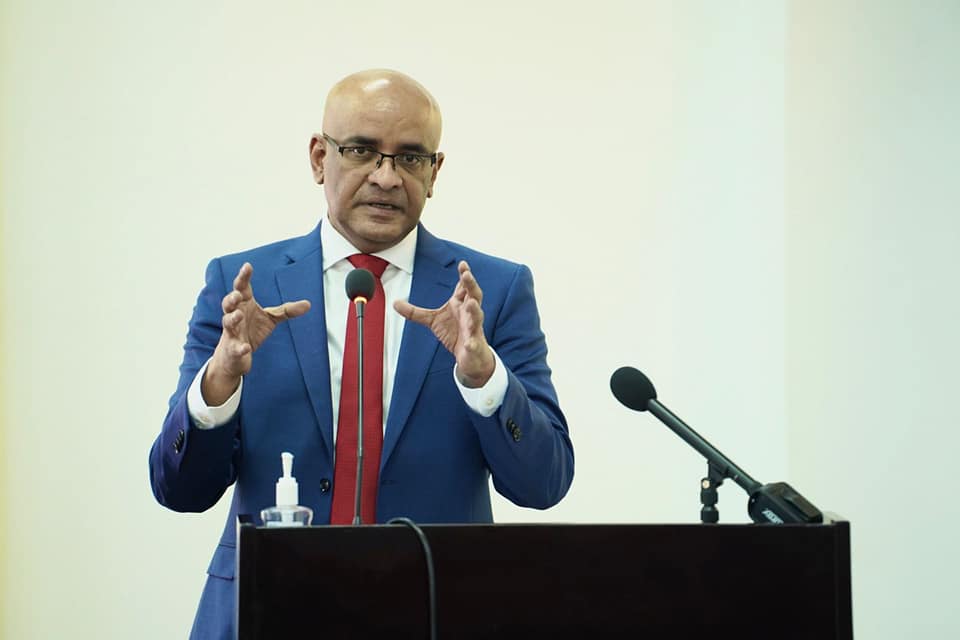Guyana’s Ministry of Natural Resources on Thursday condemned an analysis of the country’s petroleum fiscal outlook, which was produced by Tom Sanzillo, Director of the United States based Institute for Energy Economics and Financial Analysis (IEEFA).
Sanzillo, whose comments were carried in a privately owned local newspaper, claimed that every Guyanese citizen owes ExxonMobil GY$9 million and doubted that Guyana would benefit from the extraction and sale of its oil resources, among other things. The Ministry said Sanzillo’s statements are inaccurate and misleading, and provided a breakdown of comments made by Vice President Dr. Bharrat Jagdeo during a press conference on Monday, in response.
Read the full statement below:
Tom Sanzillo, Director of Financial Analysis of the Institute for Energy Economics and Financial Analysis (IEEFA) has once again presented inaccurate and misleading details on Guyana’s petroleum sector. The Vice President (VP) of Guyana, Dr. Bharrat Jagdeo was truly clear at his recent press conference on the expected revenues that this country will be receiving from around 2026. The VP stated that by that time we will be producing over 800,000 barrels of oil per day, from four producing oil fields. With that amount of oil being produced daily, then with a conservative price of US$50 per barrel, Guyana will see around US$2 billion in annual inflows to the state. The VP presented that analysis for the future, not for the previous years as Mr. Sanzillo misrepresented to the media.
Guyana’s oil earnings per capita by 2025 could exceed Qatar, Kuwait and Norway – Expert | OilNOW
Further, it can be seen that the Director does not have a full understanding of Guyana’s oil and gas sector, nor does he know the fiscal regime of the Stabroek Block. As such, the following facts are presented:
- Oil production in Guyana started in December 2019 from the Liza Destiny Floating Production Storage Offloading (FPSO) facility with peak oil set at 120,000 barrels per day (bpd).
- The second production platform started in February of this year on the Liza Unity FPSO which will have peak oil at 220,000 bpd.
- The third production FPSO will be called Prosperity with a capacity of 220,000 bpd.
- The fourth production vessel will be called One Guyana with a capacity of 250,000 bpd.
- Guyana’s fiscal regime for the Stabroek Block is set with a cost recovery ceiling of 75%, not 100%, as has been inaccurately stated by IEEFA. The royalty is fixed at 2% and the profit share ratio is 50:50, thereafter.
Exxon’s 5th project could produce up to 275,000 bpd, with first oil as early as 2026 | OilNOW
These are the facts on which the Vice President presented his analysis and the basis for the projected fiscal outlook for Guyana. The Director at IEEFA should recheck his work before trying to pronounce on Guyana. In addition, Guyana has a fully integrated fiscal and economic model that allows for the government to analyse all the producing oil fields, as well as options for the future production of oil and gas. Such tools allow the government to have a good understanding of the forecasted costs, revenues, and Net Cash Flow (NCF) from the sector for both the government take and contractors’ take. Thus, with a growing population, and increasing public, private and social investments, it is extremely pellucid that the author of the article is not familiar with effective petroleum revenue management.
Moreover, in Tom Sanzillo’s verdict on Guyana’s fiscal deficit and repayment, he fails to show any real analysis. The Vice President stated in a comprehensive manner that Guyana now has one of the lowest debts in the world and that the country’s capacity to repay has now been improved with the revenues being received from the oil and gas sector. It must be emphasized that Guyana has been doing debt restructuring and repayment under the PPP/C government, with effective debt sustainability analysis. As such, Tom Sanzillo has not done any proper study on this economy’s debt repayment programme.
Gas-to-Energy project will be star performer in Guyana’s low carbon push | OilNOW
The Director asserted that the budget imbalance should be closed based on an International Monetary Fund (IMF) assessment, noting that it is a negative macroeconomic situation for Guyana. However, he failed to analyse the country’s budgetary deficit. In an emerging country like Guyana, a low budget deficit is a positive indication and important to finance infrastructure development to support future growth.
IMF defines a modest fiscal deficit as 3-10% of Gross Domestic Product (GDP). Guyana’s budget deficit for 2012-2022(F) is within this range. The 2022 budget deficit is projected as 3.7% of GDP. The COVID-19 epidemic caused the biggest budget deficits of 6.04% and 6.74% percent in 2020 and 2021, albeit below the 10% criterion. Budgets 2020 and 2021 earmarked large resources to mitigate the damage and boost the economy. In this context, the budget deficit was essential and well-justified, while remaining below 10% of GDP.
Further, even before the crisis, the average budget deficit for Latin America and the Caribbean in 2020 was 9% of GDP, according to an Inter American Development Bank (IADB) analysis. Latin America and the Caribbean’s median budget deficit for 2022 is 4.6% of GDP. Guyana’s budget deficit projected for 2022 is below the regional average and below the minimal sustainable standard.
Tom Sanzillo does not understand the necessity for evidence-based analysis to influence his judgment. Tom Sanzillo’s analysis is erroneous. Guyana’s national debt and budget deficit are solid and regarded as macroeconomically stable.



